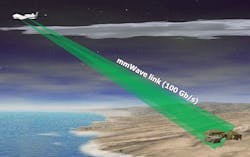DARPA moving forward with effort to develop 100-gigabit-per-second airborne wireless data links
ARLINGTON, Va., 16 March 2015. U.S. military researchers are moving forward on a project to develop a military wireless data link able to transmit data at speeds as fast as 100 gigabits per second within one RF and microwave frequency channel.
Officials of the U.S. Defense Advanced Research Projects Agency (DARPA) in Arlington, Va., released a solicitation last week (DARPA-BAA-15-22) for the second and third phases of the 100 Gb/s RF Backbone (100G) program.
These phases of the 100G program will reduce the number of participating contractors from six to two, and the two companies picked will share about $27 million.
While the first phase of the 100G program established a technology base for 100-gigabit-per-second RF data links at long ranges, the second and third phases will build an integrated prototype airborne data link for flight testing.
The 100G program seeks to create an airborne communications link with fiber-optic-equivalent capacity and long reach that can propagate through clouds, rain, and fog, and provide high availability.
Related: Latest contract brings to six the companies designing DARPA 100G wireless network
The six contractors from the program's first phase are the Northrop Grumman Corp. Aerospace Systems segment in Redondo Beach, Calif.; the Raytheon Co. Network Centric Systems segment in Tucson, Ariz.; Battelle Memorial Institute in Columbus, Ohio; Silvus Technologies Inc. in Los Angeles; Trex Enterprises Corp. in San Diego; and Applied Communication Sciences in Basking Ridge, N.J.
These six contractors, who won 100G phase-one contracts in summer 2013, focused on approaches for high-order modulation and spatial multiplexing.
The winning two contractors will develop a prototype airborne data link that uses advances in high-order modulation and spatial multiplexing to achieve 100-gigabit-per-second wireless data throughput at ranges of 62 miles for air-to-ground links and 125 miles for air-to-air links from manned or unmanned aircraft flying at about 60,000 feet.
The 100G prototype resulting from the program's second and third phases will operate in the 71-to-76 GHz and 81-to-86 GHz bands, and will be flight tested at a government test facility such as the China Lake Naval Weapons Center near Ridgecrest, Calif., DARPA officials say.
Related: DARPA releases solicitation for 100G wireless airborne data communications program
The program's 100-gigabit-per-second airborne data links are to connect the major nodes of military networks, and to handle voice, video, Internet, and enterprise data flows.
Although the U.S. civil telecommunication infrastructure relies heavily on single-mode optical fiber as the data backbone, military communications cannot rely on a fixed infrastructure for deployed operations, DARPA experts explain.
Instead, the military needs to project fiber-optic-equivalent capacity anywhere within its area of responsibility with a relative lack of communications infrastructure.
Companies interested in bidding on the second and third phases of the DARPA 100G program should respond no later than 28 April 2015 to the DARPA Website at https://baa.darpa.mil.
Email questions or concerns to DARPA at [email protected]. More information is online at https://www.fbo.gov/spg/ODA/DARPA/CMO/DARPA-BAA-15-22/listing.html.

